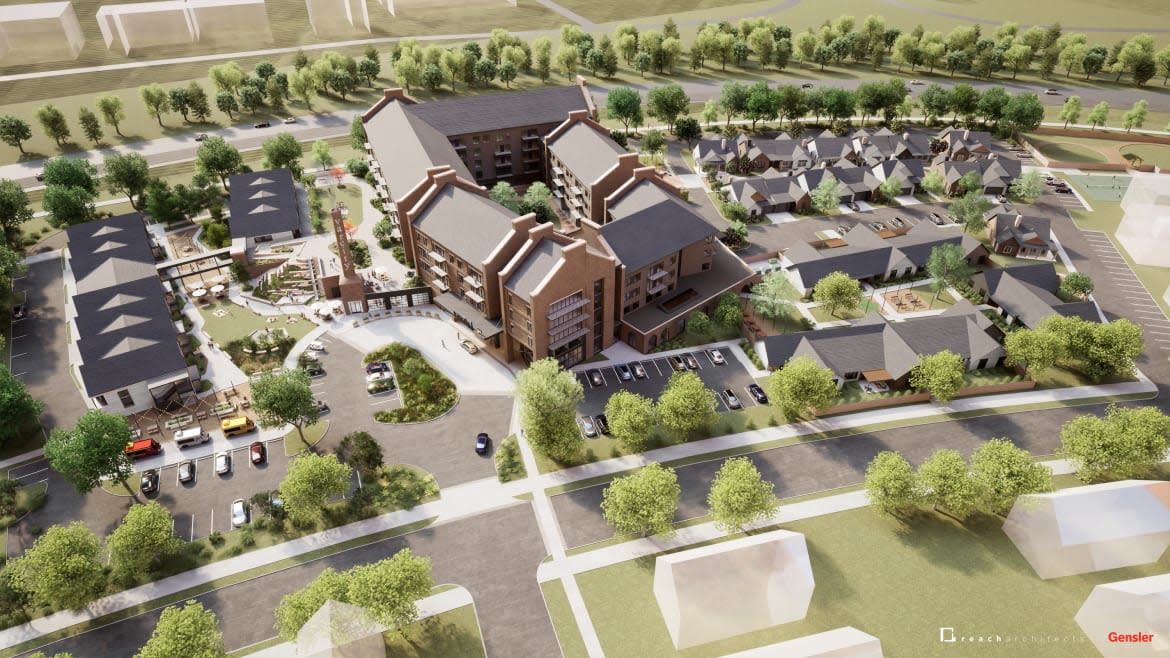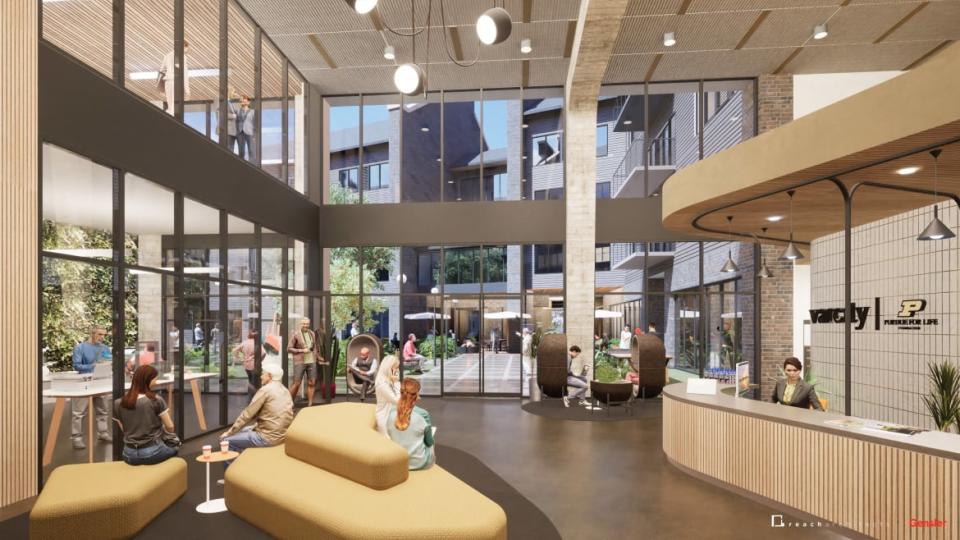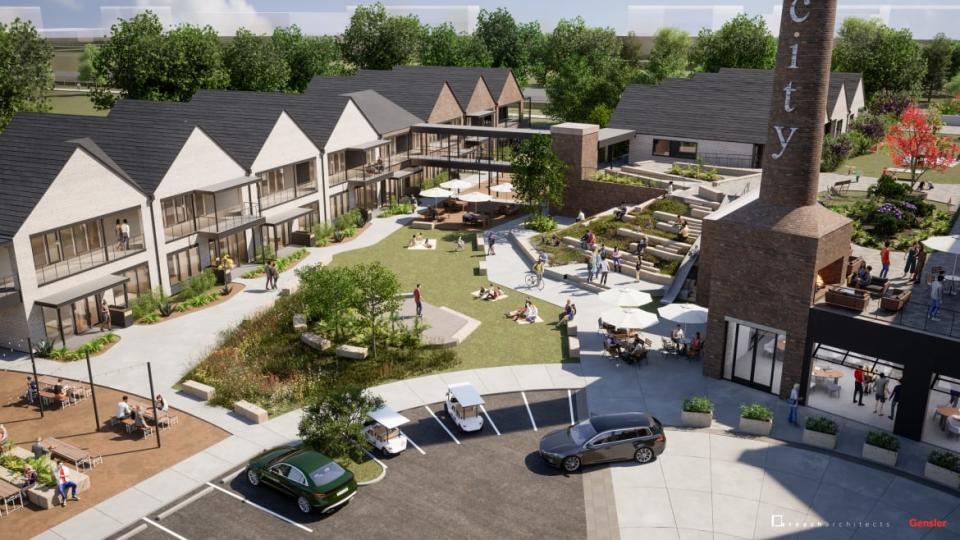Why Your Grandparents Might Move to Your College Campus

A university decides to construct on-campus housing for seniors. Normal stuff, right? But the residents they’re courting aren’t in their last year of college. Quite the opposite: they’re in their sixties, and older. While their substantially younger peers may be enrolled in classes, practicing sports, or taking part in standard college revelry, these residents won’t be enrolled students—just living nearby. They may visit the library in the morning, audit a lecture class in the afternoon, and come home to their residence at night for an all-ages ballroom dancing workshop. They are mere minutes from university medical centers. And they can choose to participate in studies and research projects led by faculty and the student body.
Arizona State University, SUNY Purchase, and Purdue University are just the latest institutions hopping on the trend of intergenerational, university-based living—a concept that’s been around since the turn of the century, but is exploding faster post-pandemic than anyone predicted. McNair Interests, a real estate firm based in Houston, Texas,, even spun off a brand in January that will focus solely on developing university-based communities for older adults. Ryan Haller, the managing principal of this spin-off, called Varcity, told The Daily Beast that it plans to announce projects with at least six different colleges within the year and is planning to break ground on another half-dozen campuses by 2026.
The first of these projects will be at Purdue, which announced its partnership with Varcity last month. Developers will begin construction next January on 231 apartment, villa, and townhouse-style units located in the northeast corner of the university’s campus. While a typical resident of this community will be in their mid-sixties, the development will contain restaurants for students, residents, and West Lafayette city-dwellers, as well as multipurpose space for talks and events, Purdue for Life Foundation president Matt Folk told The Daily Beast.

The point is to guarantee interaction between young and old. “Think about how great it would be to have a pseudo-grandparent on campus to talk to or to go have Sunday dinner with,” Folk said. “There’s just so many paths of integration that can lead to special relationships and build out student life.”
Proponents of intergenerational living point to research that shows how aging populations benefit mentally and physically when interacting regularly with younger peers. Combining this research with a desperate need to revamp the current model for senior living following the COVID-19 pandemic, companies like Varcity are betting that college campuses are the future of older living. But as a high-profile dispute shows, it may be a riskier bet than these companies realize.
School’s Back in Session
Modern medicine means more people are living longer. In 2020, even as the pandemic proved especially deadly for older adults, the number of people aged 60 and over worldwide surpassed the number of children under 5 for the first time in history.
So many scientists and public health experts are now looking to ensure not just longer lifespans, but also increased healthspans: the period of life people can spend being social, active, and healthy. Indeed, healthspan is the target of a 10-year United Nations action plan called the U.N. Decade of Healthy Ageing that the organization kicked off in 2021. One of its nine guiding principles is to use “intergenerational solidarity” to enable social cohesion and exchange to support all people’s health and well-being.
Such intermingling between older and younger generations feels alien to the U.S. model of senior care, which is relatively new for human civilization.
“Intergenerational housing was the mode of human living until a couple of centuries ago,” Jung-hye Shin, a design studies and human ecology researcher at the University of Wisconsin-Madison, told The Daily Beast. “I just find it puzzling to see it become a popular trend” as Americans learn about it for the first time, she added.
Current forms of nursing homes and long-term residential care facilities did not emerge until the mid-20th century, when the government started funding them as replacements for board-and-care homes that residents would pay for out-of-pocket. In other countries, particularly ones with cultural norms regarding family and elder care, a system of placing older members of society in a group home (not always in accordance with their wishes) would be unthinkable. It’s common in countries like China and India for multiple generations of a family to live together and care for the oldest relatives, who in turn experience lower rates of acute and chronic illnesses.
Even in societies that haven’t traditionally cared for its eldest members this way, intergenerational living paradigms have been trending upward, like in the Netherlands, where the award-winning Humanitas Retirement Village incentivizes university students to live in their care facility free of charge in exchange for 30 hours of helping older residents each month.
The health benefits of intergenerational interaction and living are well-documented. Middle-aged and older folks have longer lives and better cognition when they spend more time with young people and children. At a more biochemical level, they also exhibit decreased inflammatory proteins and increased antiviral ones, according to one study. And older people who spent at least 10 hours supporting struggling school children had lower blood pressure, walked faster, and lost on average five pounds over the course of one academic year.

“We know that there are actual, documented health benefits to staying engaged and feeling that one has a meaningful role,” Sheryl Zimmerman, a researcher at the University of North Carolina, Chapel Hill who studies long-term services and supports for older adults, told The Daily Beast. “Those needs of older adults continue to be really important.”
And the benefits go both ways. A 2016 Stanford University report concluded that older adults gain meaning and purpose, while young people form meaningful relationships and access to elders’ wisdom and lived experience.
The key to designing successful intergenerational programs, wrote the authors of the report, is to refrain from forcing older and younger groups together in ways that will underscore differences and support stereotypes of either group—a single visit from a school to an assisted living home, for instance, may reinforce the misconception that all older people are frail and cannot live independently. Programs should instead facilitate mutually beneficial, ongoing relationships between older and younger people. This could look like the AARP Foundation Experience Corps, a volunteer program where people over 50 tutor low-income students—helping the kids learn, but also empowering the volunteers with an outlet where they can pass on their knowledge. Intergenerational farms are also thought to bring generations together productively and unite affinity groups as they work toward a common goal.
The Popular Diet That May Cut Down Your Risk of Dementia
A College Try
According to Haller, there’s no better time to shake up senior living in these ways than right now. The nursing home industry became a dominant form of older care in part because it was what the Silent Generation wanted, he said. However, now that their children, the Baby Boomers, are entering their sixties and seventies, they’re dissatisfied with the status quo.
“We're starting to see wholesale rejection of [senior living homes], and the Baby Boomers are telling us very clearly, ‘That was my parents' generation. I'm not interested.’” Haller said. After watching “how people were prisoners” at senior living homes during the pandemic, tomorrow’s elders are seeking alternatives.
University-based intergenerational living might not have been the first thing that came to mind, but it made a great deal of sense to Haller and his team at Varcity, which identified three problems higher education institutions are currently battling—and ones that intergenerational living could remediate.
The first is money: colleges, which take in funds from young people’s tuition fees, leave the rest of the population on the table, even as former students grow older and are saving more than their parents, Haller said.
Second, most schools nowadays have lifelong learning programs to keep alumni engaged (and donating), but these programs leave much to be desired in terms of their programming and true intergenerational buy-in.
Lastly, there’s ageism, which the U.N. called a “global challenge” in a 2021 report. “A lot of the universities are hyper-focused on diversity, equity and inclusion,” Haller said, but most chancellors will tell him, “We are doing nothing about ageism.”
Varcity’s selling point is that these intergenerational communities are a chance to bring universities out of the red, engage older adults in academic living, and reduce ageist inequities. Any of these goals would be ambitious, but achieving all three? It’s either revolutionary—or destined to fail.
This May Be Our Best Chance to Find the Secret to Longevity
Location, Location, Location
It’s clear that some sort of grand miscalculation was made by developer Pacific Retirement Services or the residents of Mirabella. The 20-story senior living community opened in December 2020 at the heart of Arizona State University’s campus—directly across the street from an electronic dance music venue that reopened the following May. A protracted noise complaint legal battle ensued between Mirabella’s residents and the nightclub, only recently reaching a settlement on March 30 of this year.
The Mirabella case has been a thorn in Haller’s side as he’s tried to pitch collaborations with Varcity to universities’ leadership. In these meetings, he’s quick to point out that Varcity’s business model is fundamentally different, since previous funding models (including the one used at Mirabella) required residents to pony up a buy-in fee, which can set them back $1 million or more.

“How are you inclusive when you’re telling people, ‘Only the people that have $800,000 to $1 million to put down can move in?’” he said. “We don't require any more than the first month’s rent to move into our communities.”
The case highlights the dangers associated with a truly central location for older residents. After all, college students will be college students.
Most universities with an intergenerational living community have instead opted to lean toward the other end of the spectrum, putting housing in the remote corners of campus or miles off-campus entirely. That has raised concerns whether such border locations might stymie intergenerational interactions and connections.
Shin, the University of Wisconsin-Madison design researcher, emphasizes three principles when teaching concepts of intergenerational living to her design students: choices, flexibility, and visibility. All residents should be able to choose mingling or independence, public or private spaces; residents should be easily able to observe an activity in a space and decide if they’d like to take part; and they should be able to use a space in different ways depending on their needs.
Residents in a space that has these qualities will by nature be given the opportunity to not engage intergenerationally at all—that’s a real outcome that some people will choose in co-housing as well as intergenerational regenerative farming communities, Shin said.
In the field of lifelong learning, retention and engagement is a perennial concern. But Zimmerman said she is optimistic that these on-campus communities might begin to change these patterns.
“There are very few, if any, paths that I know of to make intergenerational integration actually happen, and it sounds like this new model is really quite purposeful about that,” she said.
At the end of the day, these intergenerational communities are housing, and an on-campus location is prime real estate. Universities around the country are faced with student housing shortages that they can’t just build windowless dorms from hell to resolve. Moreover, some estimates put the rates of housing insecurity faced by students and two- and four-year colleges near 50 percent. How might they react to high rollers moving into amenity-filled housing?
Folk said that at least for Varcity’s community at Purdue, this tension won’t be present.
“This doesn't take any resources from the university at all,” he said, adding that Purdue is working hard to provide additional options for a recently reported housing shortage, including announcing an 1,000-bed student housing project on April 14.
Based on how future residents and student bodies interact or don’t, said Shin, on-campus intergenerational living projects have both real risks, and potential benefits. It’s up to developers to tread carefully.
“It could go either way,” she said. “You could aggravate a sense of inequality or social stratification—but if you do it well, it can actually solve some of those sticky issues.”
Get the Daily Beast's biggest scoops and scandals delivered right to your inbox. Sign up now.
Stay informed and gain unlimited access to the Daily Beast's unmatched reporting. Subscribe now.

